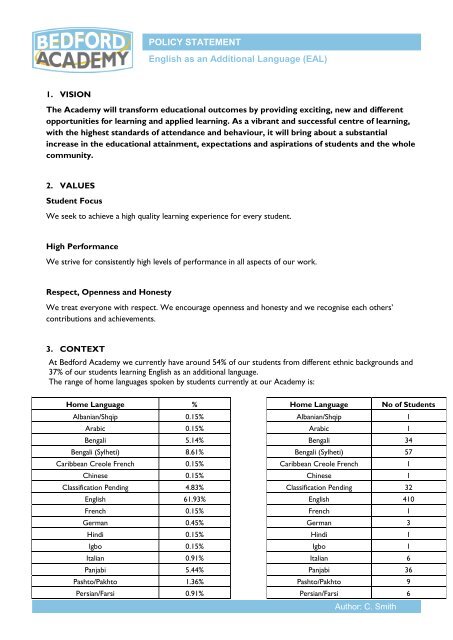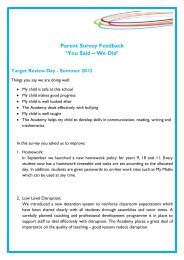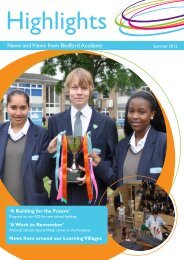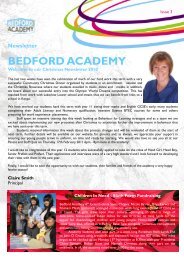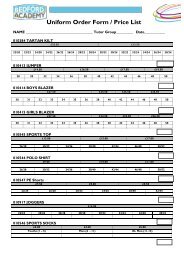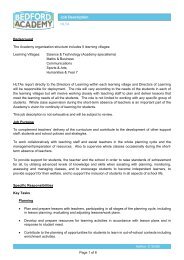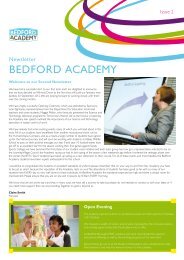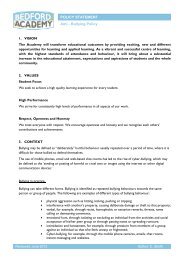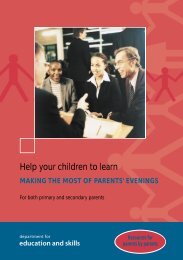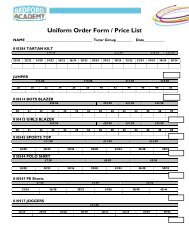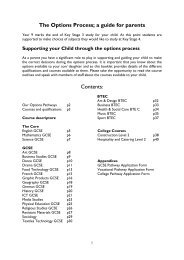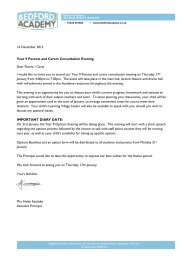procedure for handling enquiries about the ... - Bedford Academy
procedure for handling enquiries about the ... - Bedford Academy
procedure for handling enquiries about the ... - Bedford Academy
Create successful ePaper yourself
Turn your PDF publications into a flip-book with our unique Google optimized e-Paper software.
POLICY STATEMENT<br />
English as an Additional Language (EAL)<br />
1. VISION<br />
The <strong>Academy</strong> will trans<strong>for</strong>m educational outcomes by providing exciting, new and different<br />
opportunities <strong>for</strong> learning and applied learning. As a vibrant and successful centre of learning,<br />
with <strong>the</strong> highest standards of attendance and behaviour, it will bring <strong>about</strong> a substantial<br />
increase in <strong>the</strong> educational attainment, expectations and aspirations of students and <strong>the</strong> whole<br />
community.<br />
2. VALUES<br />
Student Focus<br />
We seek to achieve a high quality learning experience <strong>for</strong> every student.<br />
High Per<strong>for</strong>mance<br />
We strive <strong>for</strong> consistently high levels of per<strong>for</strong>mance in all aspects of our work.<br />
Respect, Openness and Honesty<br />
We treat everyone with respect. We encourage openness and honesty and we recognise each o<strong>the</strong>rs’<br />
contributions and achievements.<br />
3. CONTEXT<br />
At Bed<strong>for</strong>d <strong>Academy</strong> we currently have around 54% of our students from different ethnic backgrounds and<br />
37% of our students learning English as an additional language.<br />
The range of home languages spoken by students currently at our <strong>Academy</strong> is:<br />
Home Language % Home Language No of Students<br />
Albanian/Shqip 0.15% Albanian/Shqip 1<br />
Arabic 0.15% Arabic 1<br />
Bengali 5.14% Bengali 34<br />
Bengali (Sylheti) 8.61% Bengali (Sylheti) 57<br />
Caribbean Creole French 0.15% Caribbean Creole French 1<br />
Chinese 0.15% Chinese 1<br />
Classification Pending 4.83% Classification Pending 32<br />
English 61.93% English 410<br />
French 0.15% French 1<br />
German 0.45% German 3<br />
Hindi 0.15% Hindi 1<br />
Igbo 0.15% Igbo 1<br />
Italian 0.91% Italian 6<br />
Panjabi 5.44% Panjabi 36<br />
Pashto/Pakhto 1.36% Pashto/Pakhto 9<br />
Persian/Farsi 0.91% Persian/Farsi 6<br />
Author: C. Smith
POLICY STATEMENT<br />
English as an Additional Language (EAL)<br />
Polish 5.14% Polish 34<br />
Portuguese 0.45% Portuguese 3<br />
Russian 0.45% Russian 3<br />
Serbian/Croatian/Bosnian 0.60% Serbian/Croatian/Bosnian 4<br />
Swahili/Kiswahili 0.30% Swahili/Kiswahili 2<br />
Urdu 1.21% Urdu 8<br />
Yoruba 0.91% Yoruba 6<br />
(blank) 0.30% (blank) 2<br />
Grand Total 100.00% Grand Total 662<br />
In<strong>for</strong>mation is ga<strong>the</strong>red <strong>about</strong>:<br />
Student’s linguistic background and competence in o<strong>the</strong>r language(s)<br />
Student’s previous educational experience<br />
Student’s family and biographical background<br />
A member of staff is nominated to have overall responsibility <strong>for</strong> Language Development and EAL: Trish<br />
Wrightson.<br />
4. PRINCIPLES<br />
EAL students are entitled to <strong>the</strong> full curriculum offer at <strong>the</strong> <strong>Academy</strong> and all <strong>the</strong>ir teachers have a<br />
responsibility <strong>for</strong> teaching English as well as o<strong>the</strong>r subject content.<br />
Bed<strong>for</strong>d <strong>Academy</strong> has a responsibility to support students to become fully integrated into <strong>the</strong><br />
<strong>Academy</strong> and community irrespective of <strong>the</strong>ir background, ethnicity or home Language.<br />
Key Principles of Language Acquisition<br />
Access to learning requires attention to words and meanings embodied in <strong>the</strong> curriculum area.<br />
Meanings and understanding cannot be assumed but must be made explicit.<br />
Language is central to our identity. There<strong>for</strong>e, <strong>the</strong> home languages of all students and staff should be<br />
recognised and valued. Students should be encouraged to maintain <strong>the</strong>ir home language and use in<br />
<strong>the</strong> <strong>Academy</strong> environment as well as develop English.<br />
Although many students acquire <strong>the</strong> ability to communicate on a day to day basis in English quite<br />
quickly, <strong>the</strong> level of language needed <strong>for</strong> study is much deeper and more detailed and can require<br />
additional support <strong>for</strong> up to ten years.<br />
Language develops best when used in purposeful contexts across <strong>the</strong> curriculum.<br />
The language demands of learning tasks need to be identified and included in planning.<br />
All staff play a crucial role in modelling uses of language.<br />
Knowledge and skills developed in learning <strong>the</strong> first language aid <strong>the</strong> acquisition of additional<br />
languages.<br />
A clear distinction should be made between EAL and Special Educational Needs.<br />
Author: C. Smith
POLICY STATEMENT<br />
English as an Additional Language (EAL)<br />
5. OPERATION<br />
Assessment<br />
All EAL students are entitled to assessments as required and all students are assessed on entry to <strong>the</strong><br />
<strong>Academy</strong> to identify <strong>the</strong>ir learning needs.<br />
Progress in <strong>the</strong> acquisition of English is regularly assessed and monitored by <strong>the</strong> Language<br />
Development team.<br />
Assessment methods are checked <strong>for</strong> cultural bias and action is taken to remove any identified.<br />
Consideration and sensitivity is given to <strong>the</strong> appropriateness of testing EAL students at <strong>the</strong> earlier<br />
stages of English acquisition.<br />
Planning, Monitoring and Evaluation<br />
Targets <strong>for</strong> EAL students are appropriate, challenging and reviewed on a regular basis.<br />
Targets set should be shared and developed (where appropriate) with <strong>the</strong> Language Development<br />
team, in particular <strong>for</strong> students at <strong>the</strong> early stages of acquisition.<br />
Planning <strong>for</strong> EAL students incorporates both curriculum and EAL specific objectives.<br />
Language Development staff regularly observe, assess and record in<strong>for</strong>mation <strong>about</strong> students’<br />
developing use of language.<br />
When planning <strong>the</strong> curriculum, staff take account of <strong>the</strong> linguistic, cultural and religious backgrounds<br />
of families.<br />
An Induction Programme exists <strong>for</strong> those students who arrive at <strong>the</strong> <strong>Academy</strong> with low levels of<br />
English language acquisition.<br />
Teaching Strategies<br />
Classroom activities have clear, shared learning objectives and use appropriate learning materials and<br />
support to enable students to participate in lessons.<br />
Wherever possible students will have access to a dual language dictionary.<br />
Key language features of each curriculum area, e.g. key vocabulary, uses of language, <strong>for</strong>ms of text,<br />
are identified.<br />
Enhanced opportunities are provided <strong>for</strong> speaking and listening, including both process and<br />
presentational talk, and use made of drama techniques and role play. Students have access to<br />
effective staff and peer models of spoken language.<br />
Additional visual support is provided e.g. posters, pictures, photographs, objects, demonstration and<br />
gesture.<br />
Additional verbal support is provided e.g. repetition, modelling, peer support.<br />
Use is made of collaborative activities that involve purposeful talk and encourage and support active<br />
participation.<br />
Author: C. Smith
POLICY STATEMENT<br />
English as an Additional Language (EAL)<br />
Where possible, learning progression moves from <strong>the</strong> concrete to <strong>the</strong> abstract.<br />
Discussion is provided be<strong>for</strong>e, during and after reading and writing activities.<br />
Scaffolding is provided <strong>for</strong> language and learning, e.g. talk frames, writing frames.<br />
Special Educational Needs and Gifted and Talented Students<br />
Most EAL students needing additional support do not have SEN. Should SEN be identified, EAL students<br />
have equal access to <strong>the</strong> <strong>Academy</strong>’s SEN provision. If EAL students are identified as Gifted and Talented, <strong>the</strong>y<br />
have equal access to <strong>the</strong> <strong>Academy</strong>’s provision.<br />
Parental/Community Involvement<br />
Staff strive to encourage parental and community involvement by:<br />
Providing a welcoming induction process <strong>for</strong> newly arrived students and <strong>the</strong>ir families/carers.<br />
Using plain English, translators and interpreters where appropriate and available, to ensure good<br />
written and spoken communications.<br />
Identifying linguistic, cultural and religious background of students and establishing contact with wider<br />
community where possible.<br />
Recognising and encouraging <strong>the</strong> use of <strong>the</strong> first language.<br />
Helping parents understand how <strong>the</strong>y can support <strong>the</strong>ir children at home, especially by continuing<br />
<strong>the</strong> development of <strong>the</strong>ir first language.<br />
6. MONITORING, EVALUATION AND REVIEW<br />
This policy will be reviewed by <strong>the</strong> Governing Body annually as part of <strong>the</strong>ir on-going cycle of review.<br />
Initial Policy: June 2010<br />
Review: June 2012<br />
Next Review: June 2015<br />
Author: C. Smith
POLICY STATEMENT<br />
English as an Additional Language (EAL)<br />
SPEAKING LISTENING READING WRITING<br />
Step 1<br />
<strong>Academy</strong><br />
Code= 1<br />
Pupils echo<br />
words/expression<br />
s drawn from<br />
classroom<br />
routines.<br />
Express basic<br />
needs, using single<br />
words or phrases<br />
in English.<br />
Listen<br />
attentively <strong>for</strong><br />
short bursts of<br />
time.<br />
Use non-verbal<br />
gestures to<br />
respond to<br />
greetings and<br />
questions <strong>about</strong><br />
<strong>the</strong>mselves.<br />
Follow simple<br />
instructions<br />
based on<br />
classroom<br />
routines.<br />
Pupils<br />
participate<br />
in reading<br />
activities.<br />
They know<br />
that, in<br />
English,<br />
print is read<br />
from left to<br />
right.<br />
They<br />
recognise<br />
<strong>the</strong>ir names<br />
and familiar<br />
words.<br />
They<br />
identify<br />
some<br />
letters of<br />
<strong>the</strong><br />
alphabet by<br />
shape or<br />
sound.<br />
Pupils use<br />
English letters<br />
and letter-like<br />
<strong>for</strong>ms to<br />
convey<br />
meaning.<br />
They copy or<br />
write <strong>the</strong>ir<br />
names and<br />
familiar words.<br />
They write<br />
from left to<br />
right.<br />
Step 2<br />
<strong>Academy</strong><br />
Code = 2<br />
Pupils copy talk<br />
that has been<br />
modelled.<br />
In <strong>the</strong>ir speech,<br />
<strong>the</strong>y show some<br />
control of English<br />
word order.<br />
Pronunciation is<br />
generally<br />
intelligible.<br />
Understand<br />
simple<br />
conversational<br />
English.<br />
Listen and<br />
respond to <strong>the</strong><br />
gist of general<br />
explanations by<br />
<strong>the</strong> teacher<br />
where language<br />
is supported by<br />
non-verbal clues,<br />
including<br />
illustrations.<br />
Pupils begin<br />
to associate<br />
sound with<br />
<strong>the</strong> letters<br />
in English<br />
and can<br />
predict<br />
what <strong>the</strong><br />
text will be<br />
<strong>about</strong>.<br />
They read<br />
words and<br />
phrases<br />
that <strong>the</strong>y<br />
have<br />
learned in<br />
different<br />
Pupils attempt<br />
to express<br />
meaning in<br />
writing,<br />
supported by<br />
oral work or<br />
pictures.<br />
Generally <strong>the</strong>ir<br />
writing is<br />
intelligible to<br />
<strong>the</strong>mselves<br />
and a familiar<br />
reader.<br />
Shows some<br />
knowledge of<br />
English<br />
sentence<br />
Author: C. Smith
POLICY STATEMENT<br />
English as an Additional Language (EAL)<br />
curriculum<br />
areas.<br />
With<br />
support,<br />
<strong>the</strong>y can<br />
follow a<br />
text read<br />
aloud.<br />
division and<br />
word order.<br />
Building on<br />
literacy in<br />
<strong>the</strong>ir first<br />
language,<br />
pupils show<br />
knowledge of<br />
<strong>the</strong> function<br />
of sentence<br />
division.<br />
SPEAKING LISTENING READING WRITING<br />
Level 1<br />
(Threshold)<br />
<strong>Academy</strong><br />
Code = 3<br />
Pupils speak <strong>about</strong><br />
matters of<br />
immediate<br />
interest in<br />
familiar settings.<br />
They convey<br />
meaning through<br />
talk and gesture<br />
and can extend<br />
what <strong>the</strong>y say<br />
with support.<br />
Their speech is<br />
sometimes<br />
grammatically<br />
incomplete at<br />
word and phrase<br />
level.<br />
With support,<br />
pupils<br />
understand and<br />
respond<br />
appropriately to<br />
straight<strong>for</strong>ward<br />
comments or<br />
instructions<br />
addressed to<br />
<strong>the</strong>m.<br />
Listen<br />
attentively to a<br />
range of<br />
speakers,<br />
including teacher<br />
presentation to<br />
<strong>the</strong> whole class.<br />
Pupils can<br />
read a range<br />
of familiar<br />
words and<br />
can identify<br />
initial and<br />
final sounds<br />
in unfamiliar<br />
words.<br />
With<br />
support,<br />
<strong>the</strong>y can<br />
establish<br />
meaning<br />
when<br />
reading<br />
aloud<br />
phrases or<br />
simple<br />
sentences<br />
and use<br />
contextual<br />
clues to gain<br />
understandi<br />
ng.<br />
They<br />
respond to<br />
events or<br />
ideas in<br />
Pupils produce<br />
recognisable<br />
letters and<br />
words in texts,<br />
which convey<br />
meaning and<br />
show some<br />
knowledge of<br />
English<br />
sentence<br />
division and<br />
word order.<br />
Most<br />
commonly used<br />
letters are<br />
correctly<br />
shaped, but<br />
may be<br />
inconsistent in<br />
<strong>the</strong>ir size and<br />
orientation.<br />
Author: C. Smith
POLICY STATEMENT<br />
English as an Additional Language (EAL)<br />
poems,<br />
stories and<br />
non-fiction.<br />
Level 1<br />
(Secure)<br />
<strong>Academy</strong><br />
Code = 4<br />
Pupils speak <strong>about</strong><br />
matters of<br />
interest to a<br />
range of listeners<br />
and begin to<br />
develop connected<br />
utterances.<br />
What <strong>the</strong>y say<br />
shows some<br />
grammatical<br />
complexity in<br />
expressing<br />
relationships<br />
between ideas and<br />
sequences of<br />
events.<br />
Pupils convey<br />
meaning sustaining<br />
<strong>the</strong>ir<br />
contributions and<br />
<strong>the</strong> listeners’<br />
interest.<br />
In familiar<br />
contexts, pupils<br />
follow what<br />
o<strong>the</strong>rs say <strong>about</strong><br />
what <strong>the</strong>y are<br />
doing and<br />
thinking.<br />
They listen with<br />
understanding to<br />
sequences of<br />
instructions and<br />
usually respond<br />
appropriately in<br />
conversations.<br />
Pupils use<br />
<strong>the</strong>ir<br />
knowledge<br />
of letter,<br />
sounds and<br />
words to<br />
establish<br />
meaning<br />
when<br />
reading<br />
familiar<br />
texts aloud,<br />
sometimes<br />
with<br />
prompting.<br />
They<br />
comment on<br />
events or<br />
ideas in<br />
poems,<br />
stories and<br />
non-fiction.<br />
Pupils use<br />
phrases and<br />
longer<br />
statements<br />
which convey<br />
ideas to <strong>the</strong><br />
reader, making<br />
some use of<br />
full stops and<br />
capital letters.<br />
Some<br />
grammatical<br />
patterns are<br />
irregular and<br />
<strong>the</strong> pupils’<br />
grasp of<br />
English sounds<br />
and how <strong>the</strong>y<br />
are written is<br />
not secure.<br />
Letters are<br />
usually clearly<br />
shaped and<br />
orientated.<br />
SPEAKING AND<br />
READING<br />
WRITING<br />
LISTENING<br />
Level 2<br />
<strong>Academy</strong><br />
Code = 5<br />
Pupils begin to show<br />
confidence when<br />
talking and listening,<br />
particularly when <strong>the</strong><br />
topics interest <strong>the</strong>m.<br />
On occasions, <strong>the</strong>y<br />
show awareness of<br />
<strong>the</strong> needs of <strong>the</strong><br />
listener by including<br />
relevant detail.<br />
Pupils’ reading of simple<br />
texts show<br />
understanding and is<br />
generally accurate.<br />
They express opinions<br />
<strong>about</strong> major events or<br />
<strong>the</strong> ideas in <strong>the</strong> stories,<br />
poems and non-fiction.<br />
They use more that one<br />
strategy such as phonic,<br />
Pupils’ writing<br />
communicates meaning in<br />
both narrative and nonnarrative<br />
<strong>for</strong>ms, using<br />
appropriate and<br />
interesting vocabulary,<br />
showing some awareness<br />
of <strong>the</strong> reader.<br />
Ideas are developed in a<br />
sequence of sentences,<br />
Author: C. Smith
POLICY STATEMENT<br />
English as an Additional Language (EAL)<br />
In developing and<br />
explaining <strong>the</strong>ir ideas<br />
<strong>the</strong>y speak clearly<br />
and use a growing<br />
vocabulary.<br />
They are beginning<br />
to be aware that in<br />
some situations a<br />
more <strong>for</strong>mal<br />
vocabulary and tone<br />
of voice are used.<br />
They usually listen<br />
carefully and respond<br />
with increasing<br />
appropriateness to<br />
what o<strong>the</strong>rs say.<br />
graphic, syntactic and<br />
contextual, in reading<br />
unfamiliar words and<br />
establishing meaning.<br />
sometimes demarcated by<br />
capital letters and full<br />
stops.<br />
Simple monosyllabic words<br />
are usually spelt correctly<br />
and where <strong>the</strong>re are<br />
inaccuracies <strong>the</strong><br />
alternative is phonetically<br />
plausible.<br />
In handwriting, letters<br />
are accurately <strong>for</strong>med and<br />
consistent in size.<br />
Level 3<br />
<strong>Academy</strong><br />
Code = 6<br />
Talk and listen<br />
confidently in<br />
different contexts,<br />
exploring and<br />
communicating ideas.<br />
Begin to adapt what<br />
<strong>the</strong>y say to <strong>the</strong><br />
needs of <strong>the</strong><br />
listener, varying <strong>the</strong><br />
use of vocabulary and<br />
<strong>the</strong> level of detail.<br />
Begin to be aware of<br />
Standard English and<br />
when it is used.<br />
Show understanding<br />
of <strong>the</strong> main pints in<br />
Read a range of texts<br />
fluently and accurately.<br />
Read independently,<br />
using strategies<br />
appropriately to<br />
establish meaning.<br />
In responding to fiction<br />
and non-fiction show<br />
understanding of <strong>the</strong><br />
main points and express<br />
preferences.<br />
Use knowledge of <strong>the</strong><br />
alphabet to locate<br />
books and find<br />
in<strong>for</strong>mation.<br />
Writing is often<br />
organised, imaginative and<br />
clear.<br />
Main features of<br />
different <strong>for</strong>ms of<br />
writing are used<br />
appropriately, beginning<br />
to be adapted to<br />
different readers.<br />
Sequences of sentences<br />
extend ideas logically and<br />
words are chosen <strong>for</strong><br />
variety and interest.<br />
Basic grammatical<br />
structure of a sentence is<br />
usually correct.<br />
Author: C. Smith
POLICY STATEMENT<br />
English as an Additional Language (EAL)<br />
discussion.<br />
Show careful<br />
listening through<br />
relevant comments<br />
and questions.<br />
Spelling is usually<br />
accurate, including that of<br />
common, polysyllabic<br />
words.<br />
Punctuation to mark<br />
sentences – full stops,<br />
capital letters and<br />
question marks – is used<br />
correctly.<br />
Handwriting is joined and<br />
legible.<br />
Author: C. Smith


